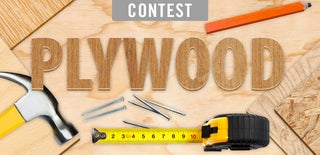Introduction: DIY Pen/Mini Lathe
I made a drill powered mini lathe that can also be used as a pen lathe. I used in line skate bearing and scrap plywood.
Step 1: Bearings and Face Plate Preperation
I went to a goodwill store and paid 2 dollars for a roller blade.
Once I got the roller blade back to the shop, I took the wheels off using two allen wrenches.
The specific part I was after was the small wheel bearings and spacers
Using ¾ in plywood I began cutting 4 pieces that would make up the face plates for the head stock and tail stock.
Ive been following izzy swans work for a while and thanks to him sharing his knowledge, i had a good idea of how i was going to make this build happen.
I drilled a pilot hole through all 4 pieces at once to ensure all holes for the bearings would line up.
I used the one in belt sander to grind a spade bit to the excact size I needed.
Using the spade bit i drilled the holes for the bearrings. I drilled deep enough so that the bearing are flush to the plywwod. Then I drilled all the waythrough with a ⅝ drill bit.
Once I got the roller blade back to the shop, I took the wheels off using two allen wrenches.
The specific part I was after was the small wheel bearings and spacers
Using ¾ in plywood I began cutting 4 pieces that would make up the face plates for the head stock and tail stock.
Ive been following izzy swans work for a while and thanks to him sharing his knowledge, i had a good idea of how i was going to make this build happen.
I drilled a pilot hole through all 4 pieces at once to ensure all holes for the bearings would line up.
I used the one in belt sander to grind a spade bit to the excact size I needed.
Using the spade bit i drilled the holes for the bearrings. I drilled deep enough so that the bearing are flush to the plywwod. Then I drilled all the waythrough with a ⅝ drill bit.
Step 2: Lathe Base and Adjustable Tail Stock Preparation
The base is a piece of plywood with two cut outs to receive the headstock side supports
I set my tablesaw to 45 degrees and cut several pieces that would make up a slide system for the adjustable tail stock.
I set my tablesaw to 45 degrees and cut several pieces that would make up a slide system for the adjustable tail stock.
Step 3: Head Stock Assembly
I pressed the bearings in and dropped two spacers in between the two bearing.
I used a 5/16 bolt and a couple of 5/16 nuts for the headstock. I cut a radius on the side supports for the headstock.
I glued and nailed the side supports and the headstock face in place, making sure everything was square.
I then went back and predilled and drove some 1 ¼ screws.
Using a tap and die set , I cut ¼ by 20 threads on the end of the 5/16 bolt. About ½ an inch of ¼ by 20 threads is all that is needed.
I used a 5/16 bolt and a couple of 5/16 nuts for the headstock. I cut a radius on the side supports for the headstock.
I glued and nailed the side supports and the headstock face in place, making sure everything was square.
I then went back and predilled and drove some 1 ¼ screws.
Using a tap and die set , I cut ¼ by 20 threads on the end of the 5/16 bolt. About ½ an inch of ¼ by 20 threads is all that is needed.
Step 4: Tail Stock Assembly
I glued and nailed one rail with a single 45 degree bevel. I wrapped a piece of paper around the piece with two opposing bevels. This is done for spacing and to ensure it slides freely.
Now I set the last piece with a single bevel and checked for clearence. Once I was happy with the fit, I used nails to hold everything temporarily. Then I went back and predrilled and drove a couple of screws in.
I traced a quick radius on the tail stock support and cut the shape out on the bandsaw. I used that piece as a template and cut the second support. I glued the tailstock face plate to sliding base, making sure not to get any glue on the stationary rails.
I glued and nailed the back supports and finished securing it together with a couple of screws.
The 5/16 bolt got the same treatment as the headstock bolt
Now I set the last piece with a single bevel and checked for clearence. Once I was happy with the fit, I used nails to hold everything temporarily. Then I went back and predrilled and drove a couple of screws in.
I traced a quick radius on the tail stock support and cut the shape out on the bandsaw. I used that piece as a template and cut the second support. I glued the tailstock face plate to sliding base, making sure not to get any glue on the stationary rails.
I glued and nailed the back supports and finished securing it together with a couple of screws.
The 5/16 bolt got the same treatment as the headstock bolt
Step 5: Tool Rest
I started to cut pieces and plywood for the tool rest.
I should have used a router the slots but it seemed like a good idea to go caveman. I had a lot of tearout but in the end they worked fine.
I should have used a router the slots but it seemed like a good idea to go caveman. I had a lot of tearout but in the end they worked fine.
Step 6: Sub Base and Drill Base
I wanted to be able to secure the lathe to a work surface so I added an overized base to the underside.
This would allow surface area so I can screw the lathe to a table.
I needed to secure the drill to the lathe in a way that would allow easy removal.
I created this assembly and made sure this whole assembly could be removed if I ever wanted to use a different drill. Of course I would need to make a different assembly but, that would not be hard to do.
I couldn't find any dowels in the shop and yes, I could not find my dowel making jig. I found a foam brush that had a 3/8 wood handle and that was a good alternative.
This would allow surface area so I can screw the lathe to a table.
I needed to secure the drill to the lathe in a way that would allow easy removal.
I created this assembly and made sure this whole assembly could be removed if I ever wanted to use a different drill. Of course I would need to make a different assembly but, that would not be hard to do.
I couldn't find any dowels in the shop and yes, I could not find my dowel making jig. I found a foam brush that had a 3/8 wood handle and that was a good alternative.
Step 7: Tool Rest Adjustments
I insterted a 1/4 by 2 inch carriage bolt through the base and tool rest.
I made a quick knob, using a t nut.
I used a couple of carriage bolts and wing nuts to complete the adjustable the tool rest.
I made a quick knob, using a t nut.
I used a couple of carriage bolts and wing nuts to complete the adjustable the tool rest.
Step 8: Workpiece Preparation
The spur center is a ¼ t-nut with the tabs bent forward.
To prepare the work piece I drilled a 3/16 hole and used a hammer to set the spur center in place.
Now was ready to give it a test run.
screwed the work piece in place. I secured the tailstock and made all the neccesary adjustments.
I put my safety gear and flipped the switch. Soon I was calling myself a turner.
I don't have much experience with turning but im sure i will get alot of practice.
To prepare the work piece I drilled a 3/16 hole and used a hammer to set the spur center in place.
Now was ready to give it a test run.
screwed the work piece in place. I secured the tailstock and made all the neccesary adjustments.
I put my safety gear and flipped the switch. Soon I was calling myself a turner.
I don't have much experience with turning but im sure i will get alot of practice.
Step 9: Mandrel
I decided i was going to make my own mandrel. I started with a ⅜ steel rod. If I had a 5/16 steel rod to start with i would have less material to remove and it would have sped up the process but I made due with what I had.
I chucked the ⅜ rod onto my drill and used a 1 in belt sander to grind most of the material away. I made sure to keep the rod moving to keep an even thickness.
This took a long time but when I got fairly close, I used a 7mm bushing as a guide. I would slide the bushing onto the mandrel and mark the area where it was binding.
Keeping the mandrel chucked to the drill, I used a piece of 220 sandpaper to slowly grind it down further. Once the bushing passed through the length of the mandrel, I knew it the perfect thickness.
I cut the mandrel to size and cut ¼ by 20 threads on both ends. I was eager to try this mandrel and I quickly found this mandrel worked perfectly.
I chucked the ⅜ rod onto my drill and used a 1 in belt sander to grind most of the material away. I made sure to keep the rod moving to keep an even thickness.
This took a long time but when I got fairly close, I used a 7mm bushing as a guide. I would slide the bushing onto the mandrel and mark the area where it was binding.
Keeping the mandrel chucked to the drill, I used a piece of 220 sandpaper to slowly grind it down further. Once the bushing passed through the length of the mandrel, I knew it the perfect thickness.
I cut the mandrel to size and cut ¼ by 20 threads on both ends. I was eager to try this mandrel and I quickly found this mandrel worked perfectly.
Step 10: Pen Turning
I was able to successfully turn several pens and the lathe and mandrel worked great.
Step 11: Further Information
If you would like further information regarding this build please check out my build video.

Runner Up in the
Plywood Contest











